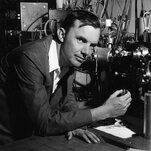
Lewis Branscomb, Champion of Science Across Fields, Dies at 96
Dr. Branscomb led the National Bureau of Standards (now the National Institute of Standards and Technology), the federal government’s authoritative standards and measurements laboratory, from 1969 to 1972. He later served as I.B.M.’s chief scientist, was a professor at Harvard University, wrote hundreds of papers and wrote or contributed to about a dozen books.
Dr. Branscomb started working for the government in the wake of World War II, and almost six decades later advised the Senate on America’s vulnerabilities after the terrorist attacks on Sept. 11, 2001.
In the interim, he developed basic scientific techniques and refined measurements at the National Bureau of Standards; helped I.B.M. turn its computers from hulking mainframes, which could cost more than an automobile, into something that could fit in a home office; and advised multiple presidents, including Lyndon B. Johnson, Richard M. Nixon and Ronald Reagan, on policy matters, particularly the space program.
Irving Wladawsky-Berger, a former I.B.M. researcher and executive, said in a phone interview that Dr. Branscomb played a major role at the company when it was leading the development of technology like computer memory and storage, networking products and semiconductors. Dr. Branscomb “had the vision of making sure that I.B.M. was a world class research company,” he said.
Dr. Branscomb called for technological growth to be driven as much by private industry as by the Defense Department and other government agencies, and expressed concern that the end of the space race with the Soviet Union had led to a diminished NASA.

